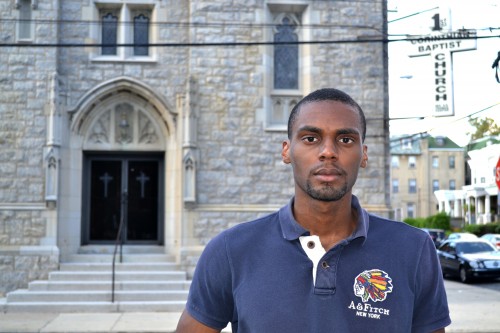
Tobi Akindoju stands outside First Corinthian Baptist Church, the focal point of his research. (Terrence Casey / Penn Memory Center)
An elderly person’s cognitive health is largely dependent on his or her environment, and West Philadelphia is several large steps away from being an age-friendly neighborhood, according to recent research.
The neighborhood’s necessary improvements — including a decrease in crime and an increase in age-friendly transportation options — were highlighted in a community health mapping project recently presented at the University of Pennsylvania by Tobi Akindoju.
Akindoju, a senior majoring in economics at Yale University, spent his 2015 summer interning with the Penn Memory Center via the Summer Undergraduate Minority Research Program. (Learn more about Tobi Akindoju here.)
“Older citizens in the neighborhood want to see change in their living environments,” Akindoju said. “All that is needed is an investment on the part of the city to make this area more age-friendly.”
Akindoju studied the area surrounding First Corinthian Baptist Church, a “community hub,” where he met with local residents.
He found that few options for healthy eating, medical care, and exercise could be found within a walking distance of the church, and uneven sidewalks posed a risk for seniors who dared to travel on foot. Transportation was often not available to these seniors either, making it “arguably the most significant problem,” he said.
Focus group participants were concerned with their safety in the mapped region, especially in public parks like Malcolm X, located across the street from First Corinthian.
“The park is not appealing to me,” one participant is quoted as saying. “There are some services, but for me to go over there and sit, no way, I would have to have a rifle with me.”
Akindoju made recommendations to the City of Philadelphia regarding the First Corinthian community, including:
- Increasing park use by older adults by decreasing crime, reducing clutter
- Increasing number of fresh food options and providing seniors with transportation (either public or through use of ride-sharing technology like Uber and Lyft)
- Increasing the number of bus stops and shaded bench areas